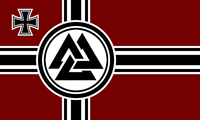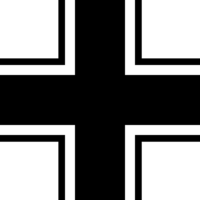Wehrmacht (Altenland): Difference between revisions
(Replaced content with "WIP.") Tag: Replaced |
|||
| (9 intermediate revisions by the same user not shown) | |||
| Line 1: | Line 1: | ||
{{Infobox national military | |||
|name = Wehrmacht | |||
|native_name = "Defense Force" | |||
|image =[[File:ValkistWarFlag.png|200px]] | |||
|caption = ''Reichskriegsflagge'', the war flag and naval ensign of the Wehrmacht | |||
|image2 = [[File:Kaiserkreuz.png|200px]] | |||
|caption2 = Emblem of the ''Wehrmacht'', the ''Kaiserkreuz'' | |||
|headquarters = [[Hochstadt]], [[Altenland]] | |||
|commander-in-chief = [[Martin Winter]] | |||
|minister = [[Bruno Graf von Scharnhorst]] | |||
|minister_title = Kriegsminister | |||
|commander = | |||
|commander_title = | |||
|branches = {{flagicon_image|WehrmachtHelmetDecal.png}}[[Heer (Altenland)|Heer]]<br>{{flagicon_image|WehrmachtHelmetDecal.png}} [[Luftwaffe (Altenland)|Luftwaffe]]<br>{{flagicon_image|WehrmachtHelmetDecal.png}} [[Kriegsmarine (Altenland)|Kriegsmarine]] | |||
|age = 18-35 | |||
|conscription = Limited | |||
|manpower_data = | |||
|manpower_age = | |||
|available = | |||
|fit = | |||
|reaching = | |||
|active = 2,200,000 | |||
|ranked = | |||
|reserve = 1,300,000 | |||
|deployed = | |||
|amount = | |||
|percent_GDP = | |||
|domestic_suppliers = | |||
|foreign_suppliers = | |||
|imports = | |||
|exports = | |||
|history = | |||
|ranks = [[Wehrmacht Ranks]] | |||
}} | |||
The '''''Wehrmacht''''' ("defense force") are the unified armed forces of [[Altenland|Valkist Altenland]]. It consists of the [[Heer (Altenland)|Heer]] (army), [[Luftwaffe (Altenland)|Luftwaffe]] (air force), and [[Kriegsmarine (Altenland)|Kriegsmarine]] (navy). The designation ''"Wehrmacht"'' replaced the previously used term ''Reichswehr'', which represented the armed forces and the post-[[Great War (Verthandi)|Great War]] [[Altish Empire]], and serves as the manifestation of the Valkist regime's efforts to rearm Altenland to a greater extent than the [[Treaty of Verdon]] permitted. | |||
After the [[Valkistiche Volkspartei|Valkists]] rose to power in 1928, one of [[Martin Winter]]'s most overt and audacious moves was to establish the ''Wehrmacht'', a modern and offensively capable fighting force. In his first few years in power, Winter moved to violate most of Altenland's military restrictions by reinstituting conscription, expanding the size of the armed forces well beyond 150,000, constructing tanks and submarines, and forming an air force, the ''Luftwaffe'', which was strictly forbidden by Verdon. This has required massive investment and defense spending on the arms industry. | |||
=Origin= | |||
===Etymology=== | |||
The Altish term ''"Wehrmacht"'' stems from the compound word of {{wp|German language|Altish}}: ''wehren'', "to defend" and ''Macht'', "power, force". It is used to describe any nation's armed forces; for example, ''Auvernisches Wehrmacht'' meaning "Auvernian Armed Forces". The [[Constitution of the Altish Empire]] of 1840 designated all Altish military forces as the "Altish ''Wehrmacht''", consisting of the ''Seemacht'' (sea force) and the ''Landmacht'' (land force). The term also appears in the Republican constitution of 1920, establishing that: "The Reich's President holds supreme command of all armed forces [i.e. the ''Wehrmacht''] of the Reich". From 1920, Altenland's national defense force was known as the ''Reichswehr''. In October 1928, after the abdication of Kaiser [[Siegfried III]] and the merging of the powers of the chancellorship and the monarchy, [[Martin Winter]] became the new commander-in-chief and thus the head of the ''Reichswehr''. In January 1931, the name was changed again to ''Wehrmacht''. | |||
===Background=== | |||
=Valkist rise to power= | |||
=Personnel and recruitment= | |||
===Women in the Wehrmacht=== | |||
=Command structure= | |||
=Branches= | |||
===Army=== | |||
===Air Force=== | |||
===Navy=== | |||
=Theaters and campaigns= | |||
[[category:Altenland]] | |||
Latest revision as of 18:26, 31 January 2024
| Wehrmacht | |
|---|---|
| "Defense Force" | |
 Reichskriegsflagge, the war flag and naval ensign of the Wehrmacht | |
 Emblem of the Wehrmacht, the Kaiserkreuz | |
| Service branches | |
| Headquarters | Hochstadt, Altenland |
| Leadership | |
| Commander-in-Chief | Martin Winter |
| Kriegsminister | Bruno Graf von Scharnhorst |
| Personnel | |
| Military age | 18-35 |
| Conscription | Limited |
| Active personnel | 2,200,000 |
| Reserve personnel | 1,300,000 |
| Related articles | |
| Ranks | Wehrmacht Ranks |
The Wehrmacht ("defense force") are the unified armed forces of Valkist Altenland. It consists of the Heer (army), Luftwaffe (air force), and Kriegsmarine (navy). The designation "Wehrmacht" replaced the previously used term Reichswehr, which represented the armed forces and the post-Great War Altish Empire, and serves as the manifestation of the Valkist regime's efforts to rearm Altenland to a greater extent than the Treaty of Verdon permitted.
After the Valkists rose to power in 1928, one of Martin Winter's most overt and audacious moves was to establish the Wehrmacht, a modern and offensively capable fighting force. In his first few years in power, Winter moved to violate most of Altenland's military restrictions by reinstituting conscription, expanding the size of the armed forces well beyond 150,000, constructing tanks and submarines, and forming an air force, the Luftwaffe, which was strictly forbidden by Verdon. This has required massive investment and defense spending on the arms industry.
Origin
Etymology
The Altish term "Wehrmacht" stems from the compound word of Altish: wehren, "to defend" and Macht, "power, force". It is used to describe any nation's armed forces; for example, Auvernisches Wehrmacht meaning "Auvernian Armed Forces". The Constitution of the Altish Empire of 1840 designated all Altish military forces as the "Altish Wehrmacht", consisting of the Seemacht (sea force) and the Landmacht (land force). The term also appears in the Republican constitution of 1920, establishing that: "The Reich's President holds supreme command of all armed forces [i.e. the Wehrmacht] of the Reich". From 1920, Altenland's national defense force was known as the Reichswehr. In October 1928, after the abdication of Kaiser Siegfried III and the merging of the powers of the chancellorship and the monarchy, Martin Winter became the new commander-in-chief and thus the head of the Reichswehr. In January 1931, the name was changed again to Wehrmacht.